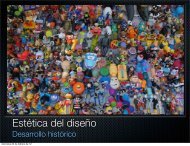Edited by Chris Jenks - carlosmoreno.info
Edited by Chris Jenks - carlosmoreno.info
Edited by Chris Jenks - carlosmoreno.info
Create successful ePaper yourself
Turn your PDF publications into a flip-book with our unique Google optimized e-Paper software.
ADVERTISING: THE RHETORICAL IMPERATIVE<br />
of the methods that some advertisers were using, ‘<strong>by</strong> today’s standards<br />
most ads were straightforward and <strong>info</strong>rmative’ 5 . Williams makes much<br />
the same case, in reverse order, saying that, ‘while the majority of<br />
advertisements remained straightforward’, mountebanks and hustlers<br />
were giving the word ‘advertising’ a ‘more specialised meaning’. 6 Joseph<br />
Addison, co-founder of the Tatler, was an early student of advertising. In<br />
the Tatler for 14 September 1710, for example, he enumerates some of<br />
the devices used <strong>by</strong> advertisers to ‘catch the Reader’s Eye’. These<br />
devices include ‘Asterisks and Hands’, although ‘the N.B.’ was more in<br />
fashion at this time, as well as ‘little Cuts and Figures’ and ‘the blind<br />
Italian Character, which…gives the curious Reader fomething like the<br />
Satisfaction of prying into a Secret’. 7<br />
As Addison says, all these devices are to catch the reader’s eye, they are<br />
intended as ways of drawing attention to a thing which otherwise may<br />
‘pass over unobserved’; as such, they conform to the sense of advertising<br />
as <strong>info</strong>rming. Indeed, Addison explicitly says in this article that the third<br />
and last function that advertisments perform is to ‘<strong>info</strong>rm the World’ where<br />
they may be furnished with almost every necessity. ‘If a Man has Pains in<br />
his Head, Cholicks in his Bowels, or Spots in his Clothes, he may here<br />
meet with proper Cures and Remedies’ he explains. 8 It may also be worth<br />
noting that Addison’s example follows the form of the siquis, ‘If<br />
anyone…then …’, mentioned above.<br />
This is not, of course, to say that all advertisements were innocently<br />
<strong>info</strong>rmative at this time. Dr Johnson had some cause to be critical; as<br />
well as the advertisement for the anodyne necklace, which ‘warned every<br />
mother that she would never forgive herself if her infant should perish<br />
without a necklace’, 9 and which, as Dyer points out, employs a tactic not<br />
unknown today, 10 there was an ad for Packer’s Royal Furniture Gloss that<br />
is an early version of the sort of advertisement known today as ‘two C…s<br />
in a Kitchen’. 11 This ad is probably worth explaining in more detail. The<br />
ad is in fact a shopbill and it appeared in 1793. It depicts two women<br />
sitting opposite one another over a table in a drawing room. The carpeted<br />
room contains a bureau, and there are paintings on the walls including<br />
one over a fireplace in which there is a lit fire. The woman on the right,<br />
who has a muffler to keep her hands warm, says to the woman on the<br />
left:<br />
Your Furniture’s exceeding Nice<br />
Pray, Madam, tell to me<br />
What makes it so and what’s the Price<br />
That mine the same may be.<br />
The woman on the left, who has no muffler and sits with her back to the<br />
fire, replies:<br />
29






